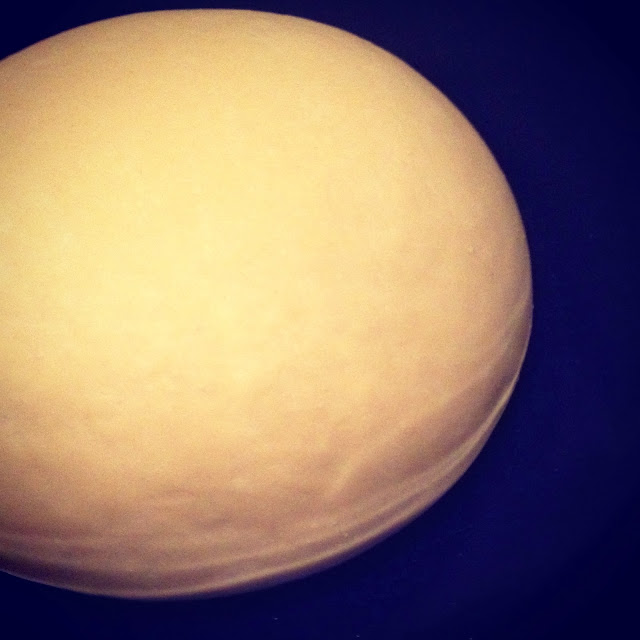My instinct is to try to cram as many vegetables into my meals as possible. The more the merrier! Pasta sauces might be a hearty mess of chopped mushrooms, peppers, and whatever else is in the fridge. Pizzas spill over with roasted squash and sautéed kale, the crust fiercely trying to support that generous blanket of produce. Forks are needed. And that is great; that is delicious and healthy and sometimes exactly what I want to eat. Flatbread overflowing with mushrooms, sage and taleggio is a house favorite and is eaten with hungry anticipation.
But. But sometimes less is more merry. Sometimes when simplicity sings you hear the melody just a little bit clearer. Sometimes all I want to eat is the best crust, the best sauce, and the best cheese. And let's forget all the fuss of making pizza at home. Start here and the possibilities are endless, but I promise that this margherita will be hard to improve upon.
First, let's talk crust. Throughout my years in kitchens, I've found that bread making and baking has an element of mystery that scares most homecooks away. Plenty have tried their hand at rolls or loaves, but one failed attempt is enough to guarantee store-bought breads for life. Yeast is weird. Bread can be time consuming and scientific and does take quite a bit of practice, which is why you should start with pizza dough. Specifically, this pizza dough recipe. It is beyond easy, requires little kneading and is a synch to clean up.
PIZZA MARGHERITA
THE DOUGH
the only dough recipe you'll ever need
makes 2 good sized pizzas that will serve 2 people each
1 1/2 cups bread flour
1 1/2 cups all-purpose flour
2 tsp salt
1 cup warm water (not too hot, not too cold!)
2 tsp yeast
Combine the yeast and water, stirring until the yeast begins to dissolve and the water turns cloudy.
In a food processor, combine the flours and salt. Pulse a few times, just to mix gently.
Turn the food processor on. Slowly drizzle in the water/yeast mixture, making sure to scrape in all of the yeast. Add more water if needed, but just spoonfuls at a time, until the dough comes together in a ball. Remove from the food processor and knead just a few times until you have a smooth ball of dough. Put in a bowl and cover. Let it rise for at least an hour.
Preheat oven to 550 degrees. If you have a pizza stone, throw it in there.
When risen, divide the dough into two balls. Lay down some parchment paper and use semolina flour to keep the dough from sticking. Using a rolling pin or your hands, stretch the dough until it is quite thin, then lay it on the parchment paper. This part takes practice, but keep at it and you'll find it can be mindlessly satisfying. And perfectly round pizzas are for nerds.
If you only want to make one pizza, freeze the second half of dough.
And now for the sauce. I've failed many a dinner by loading my beautifully stretched dough with a sloppy sauce that produces nothing more than a soggy, shameful piece of pizza. Never again! And no tricks with this sauce. All you need is a fine-meshed sieve, which any moderately stocked kitchen should possess.
THE SAUCE
makes a little too much for one large pizza, so freeze the extra or just make more pizza
1 28oz can of whole, peeled tomatoes
pinch of sugar
a little more than a pinch of salt
1 clove garlic
1 tbsp dried oregano
red pepper flakes, to taste
Put tomatoes in a fine-meshed sieve over a bowl and let drain. Mash the tomatoes with the back of a spoon to get out as much juice as possible. Save tomato juice for dressings, bloody marys or stocks.
In a bowl or blender, combine all ingredients and whizz until smooth. I use an immersion blender, which works beautifully. Taste and adjust seasoning if necessary.
THE CHEESE and THE TOPPINGS
Fresh mozzarella, but not the FRESHEST stuff that is packed in water. That moisture will leave you with sad, limp slices. Go for the vacuum-packed balls of mozzarella.
Cured olives (optional, but do it do it do it)
Fresh torn basil
Distribute mozzarella and olives over the sauce with random symmetry.
Slide the pizza (parchment paper and all!) on to your pizza stone and cook for 8 - 10 minutes, depending on your oven. It might take longer. Your crust should be browning and the cheese bubbly.
Remove from oven. Toss basil on top and slice. Best if served with more red pepper flakes and a bright arugula salad.
Italian wine, absolutely no question. More specifically, Valpolicella from the Veneto if you can get your hands on a bottle. Typically produced from three grape varietals - Molinara, Corvina, and Rodinella (Italian grape names sound like princesses, don't you agree?) - basic Valpolicellas are most similar in style to the wines of Beaujolais and Burgundy. They are fruity without being weighty and light without being lean. This 2012 bottling from Monte dall' Ora was a near perfect pairing with the richness of the sauce and creamy cheese. Full of ripe, snappy notes of cherries and raspberries, it is balanced by its true Italiannes - rustic earthiness. This wine has energy and life. The last glass was as vibrant as the first and boy, were we sad to see it go.
With a $20 price point, this Valpolicella was surprisingly wonderful and biodynamic to boot! That natural something something you can't quite put your finger on. It tastes like wine. Oh how I love it.







No comments:
Post a Comment